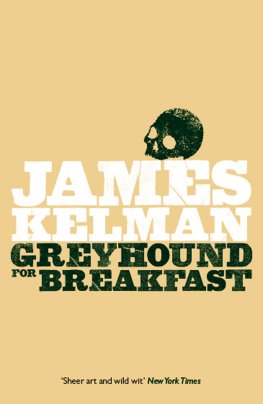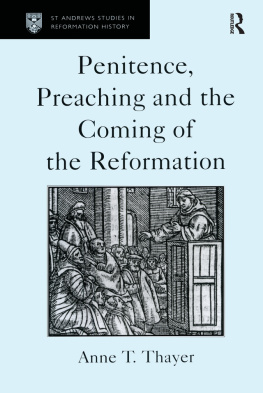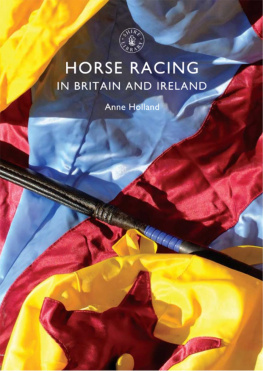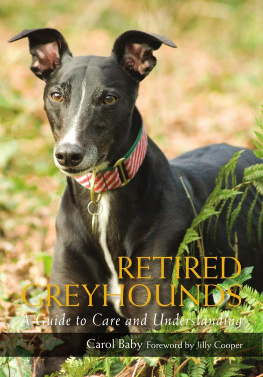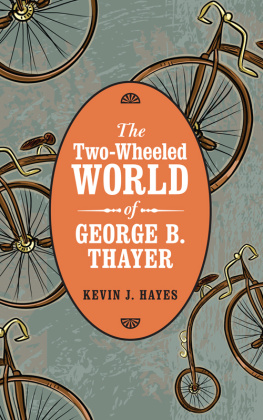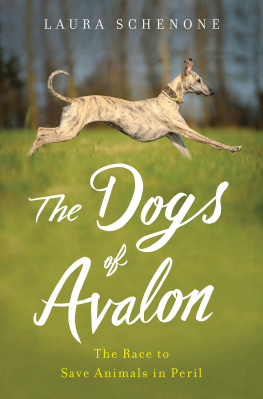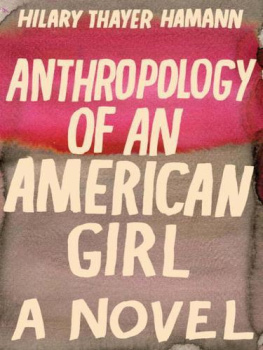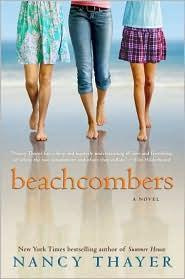2013 by the University Press of Kansas All rights reserved
Published by the University Press of Kansas (Lawrence, Kansas 66045), which was organized by the Kansas Board of Regents and is operated and funded by Emporia State University, Fort Hays State University, Kansas State University, Pittsburg State University, the University of Kansas, and Wichita State University
Library of Congress Cataloging-in-Publication Data
Thayer, Gwyneth Anne.
Going to the dogs : greyhound racing, animal activism, and American popular culture / Gwyneth Anne Thayer.
pages cm(CultureAmerica)
Includes bibliographical references and index.
ISBN 978-0-7006-1913-9 (cloth : alk. paper)
ISBN 978-0-7006-2368-6 (ebook)
1. Greyhound racingUnited StatesHistory.
2. United StatesPopular culture. I. Title.
SF440.T44 2013
798.850973-dc23
2012050036
British Library Cataloguing-in-Publication Data is available.
Printed in the United States of America
10 9 8 7 6 5 4 3 2 1
The paper used in this publication is recycled and contains 30 percent postconsumer waste. It is acid free and meets the minimum requirements of the American National Standard for Permanence of Paper for Printed Library Materials Z39.481992.
PREFACE AND ACKNOWLEDGMENTS
I am often asked why I decided to write a book on the history of greyhound racing.
The answer is simple: I adopted an ex-racing greyhound in 2004 after the heartbreaking, premature loss of my beloved mutt, Tafi.
Guiding my search for the companionship of another dog was the thought that I should find one with a story of its own. I soon inquired within the greyhound adoption community about the history of greyhound racing in the United States, but I was troubled by the lack of historical information available. I wanted to know more about the men and women who worked in the industry: Who were they? What was their relationship to their greyhounds? When was the sports heyday in this country? Why were so many tracks closing? I also wanted to know about the lives of the racing dogs. How were they raised? How were they treated at the tracks? Was greyhound racing cruel, as I had so often heard?
Everyone seemed to have a different opinion about the sport, and I was increasingly dissatisfied with the answers I was getting. Furthermore, I was looking for a book topic, and it looked like the perfect subject had just fallen into my lap.
Paired with my new greyhound, I set out on a path of discovery. It was no small irony that my greyhounds name from puppyhood was Zachary More Curious.
This book is the final product of the years of research that followed, which, much to my delight, took me to all corners of the United States. It represents my work and ideas alone, and accordingly, I am responsible for any errors. However, I could not have completed this monumental task without the help and support of others. Most important, this book would not have been possible without the cooperation of two groups of individuals: those in the business of greyhound racing and those who hope to end it. I have tried to be fair and honest during this entire process, and I have readily admitted and acknowledged (to both parties) that I must consult extensively with those who love greyhound racing as well as those who abhor it. It has admittedly been an uncomfortable tightrope to walk upon, but I have done my best to follow an ethic of integrity throughout the process.
For those in the business of greyhound racing, I am deeply indebted to Louise Weaver, assistant vice president, archivist, and historian at the Derby Lane Kennel Club, who supported my research efforts and was helpful in countless ways. I would especially like to thank Gary Guccione, executive director of the National Greyhound Association in Abilene, Kansas. Gary answered hundreds of my questions, whether by phone call, e-mail, or personal interview. Kathy Lounsbury at the Greyhound Hall of Fame was a tremendous resource, and along with the resident greyhounds, helped me find countless archival treasures during my many visits to Abilene. This book would simply not have been possible to complete without the help and support of Louise, Gary, and Kathy.
Paul Hartwell, of the Hartwell family racing dynasty, was always enthusiastic and helpful when I challenged him to dig into the past and remember the early years of greyhound racing and to recount his fathers stories. I am grateful to Mr. Hartwell and his family for allowing me to visit him in Carlsbad, California, in 2010 to conduct an oral history interview. Not long before his death, Keith Dillon graciously invited me into his home in Olathe, Kansas, for an oral history interview, now archived at the Kansas State Historical Society. Jim Frey also agreed to an oral history interview that is now housed at Baylor University. Both showed me great kindness as I asked questions about their many years of work in the industry. Mr. Frey even shared records with me from his personal files about the Florida strikes.
I must also thank all of the individuals involved in the greyhound racing business with whom I corresponded or spoke to personally, including Tim Leuschner, Wayne Strong, Janet Strong, John Hartwell, Edward Trow, Robert Trow, Craig Randle, Arden Hartman, Bill Lee, Bill Bell, Karen Keelan, Arthur Agganis, Francie Field, Chuck Marriott, Jack Sherck, Dennis Bicsak, Henry Cashen, Teddy Palmer, Becky Brannon, Leslie Wootten, Marsha Kelly, Jeff Prince, Hoye Perry, Vera Rasnake, Theresa J. Hume, Myra Sullivan, Jesse Sullivan, Dawn Stressman, Gary Temple, Ron Wohlen, Tracy Wildey, and the entire staff at the Flying Eagles Kennel in Abilene, Kansas. Some individuals asked not to be identified, but Id like to extend my thanks to them as well. Veterinarians that I spoke with regarding various aspects of canine health or the greyhound racing industry include Dr. Scott Schwarting, Dr. Roberta Lillich, Dr. William Dugger, Dr. Jon F. Dee, Dr. Kent Law, Dr. Linda Blythe, Dr. Brad Fenwick, Dr. Jill Hopfenbeck, and Dr. Gail Golab.
During the course of my research I was able to visit the following dog tracks with live racing, although some have since closed: the Palm Beach Kennel Club; Derby Lane (St. Petersburg, Florida); Southland Park Gaming & Racing (West Memphis, Arkansas); Birmingham (Alabama) Race Course; Wonderland Greyhound Park (Revere, Massachusetts); and Raynham-Taunton (Massachusetts) Greyhound Park.
Gaming industry analyst Will Cummings was extremely helpful and shared important industry data with me; he also reviewed the final chapter and offered insights that only a seasoned industry analyst could provide. Tim OBrien, the great-grandson of Owen Patrick Smith, the inventor of the mechanical lure, was a delight to speak with as well. Late in my research I came upon the work of Brian Duggan, with whom it was a pleasure to correspond and discuss the history of sight hounds. Steven Crist, who began his career at the dog tracks in Boston before he turned to the horses, kindly granted me an interview; he is presently the editor of the


